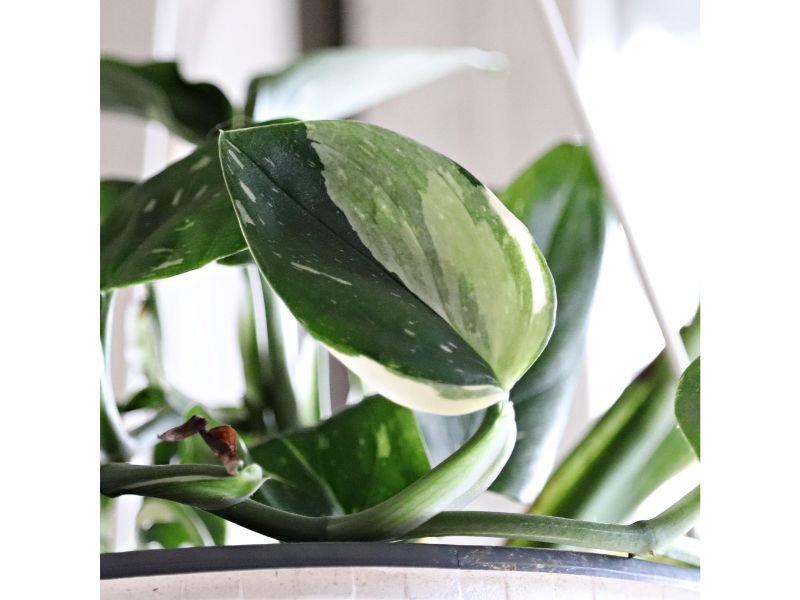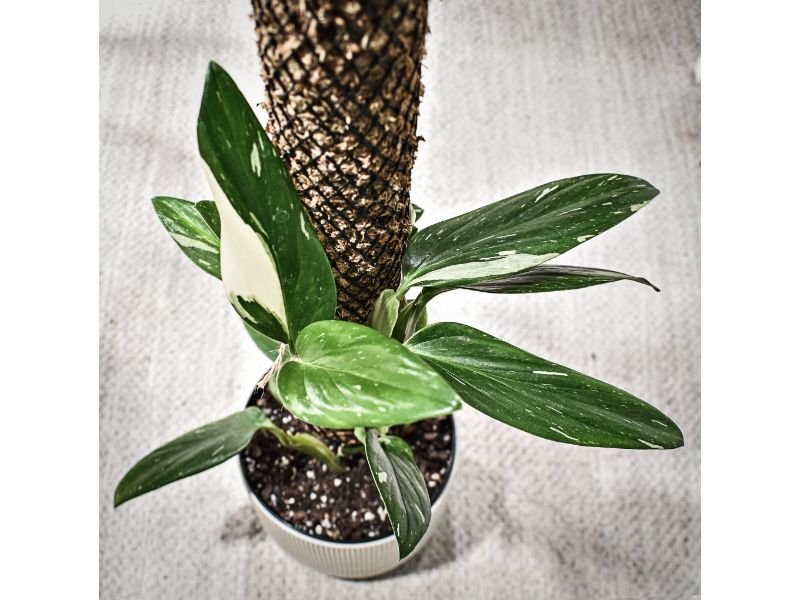Is Monstera Cobra a real plant?
Yes Monstera Cobra is a real plant. The scientific name of Monstera Cobra is Monstera standleyana ‘Albo-Cobra. Unfortunately, although being in the same family as monstera, the gorgeous monstera cobra is not part of the genus monstera, but rather the genus philodendron. So this is just a matter of naming mistakes and misconceptions.

Monstera cobra or Monstera standleyana ‘Albo-Cobra’ is a highly sought-after tropical foliage plant that is most favored for its unique variegated color. Despite its popularity, there is some debate among plant enthusiasts as to whether the monstera cobra is a true member of the Monstera genus or not–because let’s face it, these two do look nothing alike. But is a monstera cobra worthy enough to be categorized as a real monstera? If not, what’s the real deal?
Table of Contents
Monstera Standleyana Cobra vs Philodendron Cobra
Monstera and philodendrons are both part of the Arum (Araceae) Family, also known as aroids. They’re tremendously craved for being a low maintenance plant for any gardener likewise, with numerous varieties ranging from different hues, sizes, growing habits, and shapes to pick from.
One of the most obvious differences between the two plants is the foliage shape. Monstera cobra, as with any other philodendrons (with exception of split-leaf philodendrons), generally produces heart-shaped or elongated oblong-shaped foliage with pointed tips.
Meanwhile, the real monsteras produce a much more complex foliage shape, with multiple holes or splits, giving them that famous ‘Swiss cheese’ appearance. In this case, monstera cobra variegata develops no holes or splits and is favored for its creamy greenish-white or milky white variegated color that creates a beautiful contrasting color with its deep, dark green color.
Size-wise, monsteras can grow into much larger climbing vines than philodendrons and can be trained to grow upwards in moss poles. While philodendrons, generally, are more compact and bushy in their growth habit.
Although can grow up to 6 feet (182 centimeters) or more when matures, the monstera standleyana cobra mostly thrives as a small to medium-sized houseplant–same as its philodendron counterparts.
To add, monstera cobra is often marketed as philodendron cobra or philodendron cobra monstera standleyana, making it more tricky to tell these plants apart, especially if you’re new to the word of aroids. However, this is not completely wrong, as the monster cobra is a philodendron.
Monstera Cobra Variegata vs Regular Monstera and Philodendron Caring Guide

In terms of maintenance, there’s no specific need for monstera cobra as well as any other particular monstera and philodendron varieties. As a native to warm tropical regions, monstera cobra shares the same light and watering requirements as its aroid cousins. This plant loves thriving in bright but indirect sunlight, along with moist soil and a proper drainage system.
Monstera standleyana ‘Albo-Cobra is also a fan of humidity. To make them thrive, provide a growing area with a bare minimum of 60% of humidity or more. Use an aroid soil mix with a pH ranging from slightly acidic to neutral, and feed them balanced, water-soluble fertilizers once or twice a month during its growing season.
Is Monstera Cobra rare?
Monstera standleyana ‘Albo-Cobra’ is considered a rare plant in the horticultural industry. It is a cultivar of Monstera standleyana, also known as Philodendron Cobra, which is native to Central and South America.
Monstera standleyana ‘Albo-Cobra’ meets several criteria that classify it as a rare plant:
Limited availability
This plant is not commonly found in nurseries or garden centers due to its difficulty in propagation.
High demand
Monstera standleyana ‘Albo-Cobra’ is highly sought after by collectors and enthusiasts due to its striking variegation, which makes it a rare and desirable addition to a plant collection.
Unique features
This plant has unique white or cream-colored markings on its leaves, which is a rare characteristic in the Monstera family.
Propagation difficulty
Monstera standleyana ‘Albo-Cobra’ is difficult to propagate due to its slow growth and low rate of seed production. Here are some challenges which make this plant hard to propagate:
- One of the reasons for this is its slow growth rate, which means it takes longer for the plant to reach maturity and produce new growth. Additionally, this plant has a low rate of seed production, which makes it challenging to produce new plants through traditional seed propagation methods.
- The most common method of propagation for Monstera standleyana ‘Albo-Cobra’ is through stem cuttings. However, even this method can be challenging due to the slow growth rate and delicate nature of the plant. The stem cuttings must be taken from a healthy and mature plant, and it can take several months for them to develop roots and establish themselves.
- Another challenge in propagating Monstera standleyana ‘Albo-Cobra’ is the need for high humidity and warmth, which can be difficult to maintain in certain climates. This plant thrives in warm, humid environments, and any fluctuations in temperature or humidity can lead to poor growth and root development.
Overall, the combination of slow growth, low seed production, and high environmental requirements make Monstera standleyana ‘Albo-Cobra’ a challenging plant to propagate, which contributes to its rarity and exclusivity in the plant market.
Overall, the combination of limited availability, high demand, unique features, and propagation difficulty make Monstera standleyana ‘Albo-Cobra’ a rare plant.
Is Monstera Cobra Poisonous?
Aroids are known to contain calcium oxalate crystals that can cause symptoms such as swelling lips, burning sensation in mouth and throat, irritation, difficulty in swallowing, and sometimes vomiting or nausea.
While monstera cobra is not considered highly toxic, it’s still crucial to take some precautions before taking this plant home.
It’s highly recommended to keep the monstera cobra plant away from children and pets who may be curious to munch on them. Make sure to always use gloves before getting in contact with the monstera cobra variegata and wash your hands directly after. Seek medical attention immediately if accidents or poisoning symptoms occur.
If Monstera Cobra Is Not A Real Monstera, Why Do They Name It That Way?
Oftentimes, people who don’t have enough knowledge about aroids may confuse monsteras with philodendrons. The confusion may also arise from the fact that both plants are members of the Araceae Family and share some other similar characteristics, including vine-like growing habits, and ease of maintenance.
Nonetheless, there’s also a slight likelihood that various sellers intentionally give the Monstera standleyana ‘Albo-Cobra its common name and label the plant as monstera as a clever marketing tactic.
Although the price of monsteras and philodendrons varies depending on the scarcity of the variety, the size, the color, and the location where it’s being sold, in general, monsteras tend to cost much more than philodendrons. Labeling the monstera cobra as monstera would attract attention from gardeners and plant lovers who are looking for monstera plants, thus increasing the sold price.
How To Spot A Monstera Cobra Selling Scam
Scams are common practice in the plant markets, and as a plant enthusiast, it’s paramount to be aware of the signs of monstera cobra selling scams. The first thing you need to watch out for is the unrealistically too-low or too-high prices.
In the United States alone, the average price for monstera cobra varies between $50 to $200, with an exception of cut stems for propagation purposes, which can be sold at a little bit over $10 each. Please note that this is not a general rule, as prices vary depending on location, seller, and the maturity of the monstera cobra plant.
Another red flag to look out for is the poor quality photos and lack of information about this plant. Any legitimate seller would provide the best-taken photos, including not using photos that are not related to the plant as a way of marketing.
Monstera standleyana ‘Albo-Cobra is a distinctive foliage plant with glossy, thick, oval-shaped dark green and milky white foliage, with no splits or holes. Other than that, you should be aware that the plant is probably not a monstera cobra.
If the seller is not able to provide you with all the detailed information about the plant, including giving vague answers, it’s also better to move on to another marketplace. Predominantly, make sure to take more time to study the plant and their characteristics to help you make decisions before thriving your lush indoor garden.
Monstera Cobra In A Nutshell: Are They Real Plants?
To wrap things up, the Monstera standleyana ‘Albo-Cobra is a real plant from the Araceae Family that you can grow to add more aesthetic value to any indoor or outdoor scenery. However, it’s important to note that the monstera cobra is not part of the genus monstera, but rather part of the genus philodendron. Nonetheless, monstera cobra is still a breathtakingly easy-to-maintain plant that is worth thriving!

New author in the hood. Loves gardening and flowers are my spirit animals (yes I know they are not animals but I insist). I will be covering most of the flowers’ topics here and occasionally random though as well.






